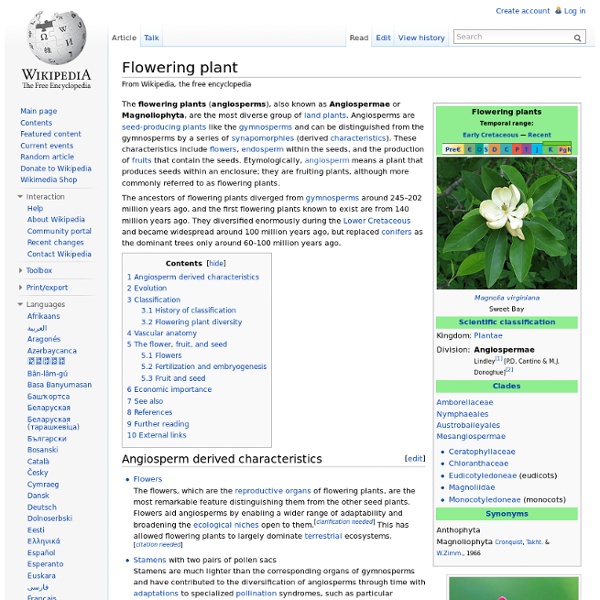Unassigned Angiospermae
[edit] Classification System: APG III (down to family level) Main Page Regnum: Plantae Cladus: Angiosperms Circulus: Unassigned Angiospermae Familiae: Genera: †Macclintockia References[edit] Angiosperm Phylogeny Group (2009). "An update of the Angiosperm Phylogeny Group classification for the orders and families of flowering plants: APG III".
Search also olive plant
Gymnosperm
Classification[edit] In early classification schemes, the gymnosperms (Gymnospermae) were regarded as a "natural" group. There is conflicting evidence on the question of whether the living gymnosperms form a clade.[1][2] The fossil record of gymnosperms includes many distinctive taxa that do not belong to the four modern groups, including seed-bearing trees that have a somewhat fern-like vegetative morphology (the so-called "seed ferns" or pteridosperms.)[3] When fossil gymnosperms such as Bennettitales, Caytonia and the glossopterids are considered, it is clear that angiosperms are nested within a larger gymnosperm clade, although which group of gymnosperms is their closest relative remains unclear. For the most recent classification on extant gymnosperms see Christenhusz et al. (2011).[4] Subclass Cycadidae Order CycadalesFamily Cycadaceae: CycasFamily Zamiaceae: Dioon, Bowenia, Macrozamia, Lepidozamia, Encephalartos, Stangeria, Ceratozamia, Microcycas, Zamia. Subclass Ginkgoidae
Angiosperms
Superregnum: Eukaryota Regnum: Plantae Divisio: Tracheophyta Classis: Magnoliopsida Ordines (64 sensu APG IV): Acorales – Alismatales – Amborellales – Apiales – Aquifoliales – Arecales – Asparagales – Asterales – Austrobaileyales – Berberidopsidales – Boraginales – Brassicales – Bruniales – Buxales – Canellales – Caryophyllales – Celastrales – Ceratophyllales – Chloranthales – Commelinales – Cornales – Crossosomatales – Cucurbitales – Dilleniales – Dioscoreales – Dipsacales – Ericales – Escalloniales – Fabales – Fagales – Garryales – Gentianales – Geraniales – Gunnerales – Huerteales – Icacinales – Lamiales – Laurales – Liliales – Magnoliales – Malpighiales – Malvales – Metteniusales – Myrtales – Nymphaeales – Oxalidales – Pandanales – Paracryphiales – Petrosaviales – Picramniales – Piperales – Poales – Proteales – Ranunculales – Rosales – Santalales – Sapindales – Saxifragales – Solanales – Trochodendrales – Vahliales – Vitales – Zingiberales – Zygophyllales
Olive
The olive ( i/ˈɒlɪv/ or Its fruit, also called the olive, is of major agricultural importance in the Mediterranean region as the source of olive oil. Description[edit] 19th century illustration The olive tree, Olea europaea, is an evergreen tree or shrub native to the Mediterranean, Asia and Africa. The small white, feathery flowers, with ten-cleft calyx and corolla, two stamens and bifid stigma, are borne generally on the previous year's wood, in racemes springing from the axils of the leaves. The fruit is a small drupe 1–2.5 cm (0.39–0.98 in) long, thinner-fleshed and smaller in wild plants than in orchard cultivars. Taxonomy[edit] There are six natural subspecies of Olea europaea distributed over a wide range:[6][7] The subspecies maroccana and cerasiformis are respectively hexaploid and tetraploid.[8] Wild growing forms of the olive are sometimes treated as the species Olea oleaster. Cultivars[edit] History[edit] Prehistory[edit] The immediate ancestry of the cultivated olive is unknown.
Callose
Callose is a plant polysaccharide. It is composed of glucose residues linked together through β-1,3-linkages, and is termed a β-glucan. It is thought to be manufactured at the cell wall by callose synthases and is degraded by β-1,3-glucanases. It is laid down at plasmodesmata, at the cell plate during cytokinesis and during pollen development. It is produced in response to wounding, infection by pathogens.,[1] aluminium and abscisic acid. Deposits often appear on the sieve plates at the end of the growing season.[2] Callose also forms immediately around the developing meiocytes and tetrads of sexually reproducing angiosperms but is not found in related apomictic taxa.[3] See also[edit] Curdlan References[edit]
Transposable element
A bacterial DNA transposon A transposable element (TE, transposon or retrotransposon) is a DNA sequence that can change its position within the genome, sometimes creating or reversing mutations and altering the cell's genome size. Transposition often results in duplication of the TE. Barbara McClintock's discovery of these jumping genes earned her a Nobel prize in 1983.[1] TEs make up a large fraction of the C-value of eukaryotic cells. Discovery[edit] Barbara McClintock discovered the first TEs in maize, Zea mays, at the Cold Spring Harbor Laboratory. TEs are more common than usually thought. Classification[edit] Transposable elements (TEs) represent one of several types of mobile genetic elements. Class I (retrotransposons)[edit] Retrotransposons are commonly grouped into three main orders: Retroviruses can also be considered TEs. Class II (DNA transposons)[edit] Class II TEs make less than 2% of the human genome, making the rest Class I.[13] Autonomous and non-autonomous TEs[edit]
Terpen
Mange terpener stammer fra harpiks, her et fyrretræ. Terpener er en stor og varieret gruppe af naturligt forekommende kulstofforbindelser, som primært produceres i mange planter, specielt i nåletræer, men også af nogle insekter, som f.eks. svalehalelarver, der udsender terpener, når de er truet. Terpener er hovedbestandelen i harpiks, og i terpentin fremstillet af harpiks ("vegetabilsk terpentin"). Navnet terpen er afledt af ordet terpentin. Terpener og terpenoider udgør hovedbestanddelen af planters og blomsters æteriske olier. Struktur og biosyntese[redigér | redigér wikikode] Isopren. Terpener er biosyntetiske derivater af isoprenenheder, som har molekylformlen C5H8. Det er de aktiverede former af isopren, isopentenylpyrofosfat (IPP) og dimetylallylpyrofosfat (DMAPP), som er reaktanter i biosyntesen af terpener. Kæderne af isoprenenheder klassificeres efter størrelse som hemiterpener, monoterpener, sesquiterpener, diterpener, sesterterpener, triterpener, and tetraterpener.



